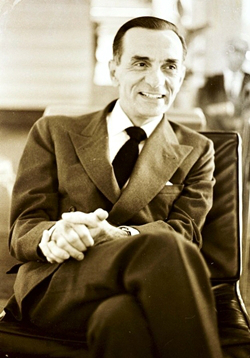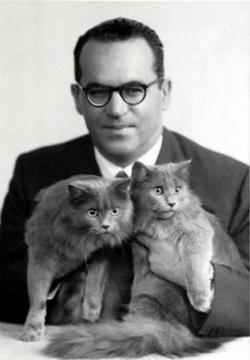The Generation of 45 represented a group of third generation modernist Brazilian literati.
She came up with “Revista Orfeu” (1947) and had representatives in both prose and poetry.
Historical context
The Second World War took place between 1939 and 1945. Therefore, the generation of 45 marks the beginning of the Cold War, the arms race, as well as the end of the second war and of many totalitarian governments, of which the German Nazism stands out.
In Brazil, the period was of the redemocratization of the country and the Vargas Era. With Getúlio Vargas in power, this phase would be marked by repression, censorship and the advancing dictatorship.
The modern arts movement sought to criticize society, while distancing itself from academic art. This gave way to folklore, regionalisms, multiple subjectivisms, among others.
It was in this context that the writers of the third modernist phase produced their works.
abstract
Modernism was an artistic and cultural movement that emerged in the 19th century, however, in Brazil it started with the Week of Modern Art , in 1922.
For being a long period that houses several authors and styles, Modernism in Brazil is divided into three phases:
The First Modernist Phase , known as the “heroic phase” begins in 1922 and runs until 1930. It was marked by radicalism, inspired by European avant-garde.
At that time, several modernist groups emerged: Pau-Brasil (1924-1925), Verde-amarelismo or Escola da Anta (1916-1929), Regionalist Manifesto (1926) and Movimento Antropófago (1928-1929)
In the Second Modernist Phase (1930-1945), known as the “Consolidation Phase”, the movement was marked by nationalism and regionalism with a predominance of “fictional prose”.
The Generation of 45, in the context of the Third Modernist Phase (1945-1980), already includes postmodern aspects. That is why it is also called the “Post-Modern Phase”, with breaks between the first and second phases.
Thus, it is clear that the initial idea disseminated by the Modernists of 22, has undergone changes over time.
In this way, the generation of 45 brought together artists concerned with seeking a new literary expression, through experimentation and aesthetic, thematic and linguistic innovations.
The Generation of 45 represented an art more concerned with words and form – in the case of João Cabral and Guimarães Rosa – while exploring essentially human subjects, as in Clarice’s work.
Both prose and poetry were explored in this period, however, in a more intimate, regionalist and urban way. In addition to intimate poetry, urban prose, intimate prose and regionalist prose are noteworthy.
Main Writers and Works
In Brazil, the prominent literati in the Generation of 45 were:
João Cabral de Melo Neto (1920-1999)

Considered the “engineer poet”, João Cabral was one of the most prominent authors of the Generation of 45. As an engineer, his work was built in a rational and balanced way.
A great highlight in poetry, his most emblematic work is “ Morte e Vida Severina ” (1955) with a Northeastern theme. In it, the author makes a social criticism about the problems experienced by the retreatants in the interior of the northeast.
– My name is Severino,
as I don’t have another sink.
As there are many Severinos,
who is a pilgrimage saint,
they then called me
Severino Maria;
as there are many Severinos
with mothers called Maria,
I became Maria
of the late Zacarias.
But that still says little:
there are many in the parish,
because of a colonel
who was called Zacarias
and who was the oldest
lord of this sesmaria.
How then do I say who I speak
to Your Lordships prays?
Let’s see: it’s Severino
da Maria do Zacarias,
from the Serra da Costela, on the
edge of Paraíba.
But that still says little:
if at least five more had,
under the name of Severino,
children of so many Marias
women of so many others,
already deceased, Zacarias,
living in the same
thin and bony mountain range in which I lived.(Excerpt from the work “Morte e Vida Severina”)
Clarice Lispector (1920-1977)

With her intimate literature, Clarice’s production is marked by introspective works of a psychological and subjective character. “ A Hora da Estrela ” (1977) stands out , the last work produced by the writer.
Everything in the world started with a yes. One molecule said yes to another molecule and life was born. But before prehistory there was prehistory of prehistory and there was never and there was yes. There always has been. I don’t know what, but I know that the universe never started.
Let no one be mistaken, I can only achieve simplicity through hard work.
As long as I have questions and there is no answer I will continue to write. How to start at the beginning, if things happen before they happen? If before pre-prehistory there were already apocalyptic monsters? If this story does not exist, it will exist. Thinking is an act. Feeling is a fact. The two together – I write what I am writing. God is the world. The truth is always an inexplicable inner contact. My most true life is unrecognizable, extremely interior and does not have a single word that means it. My heart has emptied of all desire and is reduced to the very last or first pulse. The toothache that runs through this story took a deep tug into our mouth. So I sing a high syncopated and shrill melody – it is my own pain, I who carry the world and there is a lack of happiness.Happiness? I’ve never seen a crazier word, invented by the Northeasterners who walk around in droves. (Excerpt from the work “A Hora da Estrela”)
João Guimarães Rosa (1908-1967)

With its regionalist prose, the “ Grande Sertão Veredas ” (1956) stands out . In it, the poet recreates the customs of the sertanejo and the speech of the characters through regionalist, popular and colloquial language.
“ Diadorimand me, the two of us. We used to go for walks. Thus, we were differentiated from the others – because jagunço is not much for continuous conversation or close friendships: they mix and demystify, by chance, but each one is made for himself. No one said anything about the two of us together. They had good prudence. Say one, tease, I say – I could die. They got used to seeing people alike. They didn’t even curse anymore. And we were talking, close to the gully – old farm, where the watercress blooms. From that lusfús, it was getting dark. Diadorim lit a fire, I went to get cobs. Many moths passed between our faces, and large beetles bumped. There was a breeze. The ianso of the wind came with the smell of some rain nearby. And the crickets’ chiim gathered the field in squares. For me alone, with so many details,I was not able to be astonished, I am not much of a stop; but longing reminds me. That if today was. Diadorim has put his footprint on me forever in all those nature’s scrubs. I know how I know. Sound like frogs sighed. Diadorim, hard tough, so beautiful, in the glow of the embers. ” (Excerpt from the work “Grande Sertão: Veredas”)
